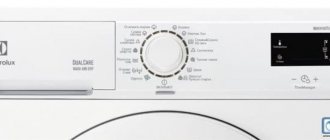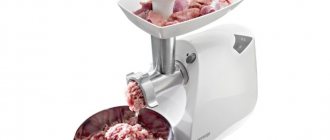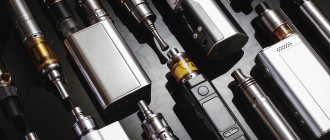Features of the first activation of the Hans PMM
Of course, before installation and first launch, you must read the instructions. Make sure your water and sewer connections are correct, purchase manufacturer-approved cleaning products, and then get started. The very first cycle is performed without dishes. But there are nuances:
- Pour approximately 1 liter of water into the salt container.
- Plug in the device and turn on the water supply.
- Among the temperature modes, choose medium, most often it is 30°-40°C.
- Activate the shortest mode, usually Eco or Express depending on the series.
- Click "Start".
- After about 10 seconds the device will start.
Safety precautions
In this section, the manufacturer gives valuable instructions, following which you will be able to use the device correctly and definitely not harm yourself:
- Check the packaging and integrity of the machine upon receipt. If you have any doubts about the integrity of the device, do not use it, but contact the seller for clarification.
- Before connecting the device to the network, the outlet must be grounded. Doing this yourself is strictly prohibited, so you will have to contact a specialist.
- Before turning on, check the electrical readings with the readings required for the operation of the Hans dishwasher.
- During installation or repair, it is necessary to turn off the power and water supply to the device.
- The manufacturer does not recommend using a connection via an extension cord, and also requests that only the original plug be used to plug into the network. The socket and plug must be quickly and easily accessible.
- The use of a Hans dishwasher by persons who have not studied safety precautions, or by people with physical or mental disabilities is prohibited if the danger of using the device is high for them.
- Separately, the instructions for the Hans dishwasher highlight the use of the device by children. Children over 8 years old are allowed to wash dishes in it, provided they have undergone instruction and understand the dangers that can occur if handled incorrectly. Children under three years of age are not allowed near the device. It is forbidden to play with the machine, drink water from the device, and detergents must be stored out of the reach of children.
- During use, remember that the water may be heated, so there is a high risk of getting burned when opening the door while running the program.
- To avoid injury from sharp objects, they are placed horizontally in the upper compartment or point down in the cutlery compartment.
- It is prohibited to use a Hansa dishwasher for purposes other than its intended purpose - washing dishes.
- Solvents must not be used in the device due to the risk of explosion.
- Do not sit down, stand up or place heavy objects on the door of the device - the machine may tip over.
- If repairs are necessary, you should contact a specialist.
These are the manufacturer’s main recommendations for safe handling of equipment. You can always find out more about the requirements and recommendations in the instructions for your model or use our article, which describes in detail the installation and connection processes of the dishwasher.
How to optimally arrange dishes in boxes
Properly arranged dishes are half the success of washing. Proper layout allows the rocker arms to spray water as efficiently as possible, as well as wash away detergent. Then there are no drips or drips left on the cutlery. Here are some tips from Hans' engineers:
- Start loading from the bottom basket/box. After drying or the end of the cycle, they also begin to unload from the bottom.
- Pots, pans, and other large items should be placed below.
- Maintain some distance between dishes, including cutlery.
- It is advisable to place plates and cups, as well as pots, upside down.
- It is most effective and safe in those PMMs that have holders and special shelves for cups, glasses, and a separate tray for forks and knives.
Loading
There are several simple loading rules that apply to all dishwashers:
- Start filling the device from the bottom basket. In the same way, you need to unload the device.
- The largest items - pots and pans - are placed downwards.
- There should be a small distance between dishes so that water can freely clean the surfaces.
- Place all cookware upside down.
Loading the machine
You can highlight the basic rules for loading products into the device, the observance of which will allow you to use it most effectively.
Upper basket
In this basket you can place fragile glassware, porcelain, as well as tea pairs, cups and glasses. You can also place cutlery between them. The dishes must be laid out so that they are not touched by the spray nozzles when the device is operating.
Important! It should be remembered that items placed in the upper basket should be lightly soiled.
Lower basket
More soiled items and deep dishes can be placed in this basket. For example: bowls, pans, baking sheets. As in the case of the top one, it is necessary to arrange objects in such a way that they do not touch them when the device is operating. And so that the water drains, it is better to place the products upside down.
Cutlery tray
If the machine is equipped with a special compartment, then cutlery should be placed in it. It is important to fold them with their handles up, place the longest utensils in the middle, and also make sure that they do not cling to each other.
You can find out more about the loading rules in the instructions for the Hansa dishwasher of your particular model. Our article on how to use a dishwasher correctly will also help you.
Let's take a closer look at the design of Hansa machines using the example of several models.
Basic modes and choosing the right one
The basic set of programs in all dishwashers of this brand is the same. This:
- Pre-washing, also known as soaking, is for heavily soiled or burnt dishes.
- Standard program - suitable for medium soiling and almost all types of dishes.
- Delicate - for glass, porcelain, crystal.
- Eco mode is economical and environmentally friendly, not suitable for heavy pollution.
- Night - the quietest mode, medium in duration. Typically the temperature is 50°C.
There are others, but the most popular ones are listed above.
Program selection
Different models of Hans dishwashers have their own characteristics. We list the main functions that are found in almost all devices:
- Pre-wash or pre-soak - used when you need to soak stuck or burnt-on food residues.
- High-intensity washing allows you to remove the most stubborn stains at temperatures of +65 - +70°C.
- Standard sink - for cleaning dishes from medium to heavy stains.
- Eco-wash is used for all degrees of soiling, except heavy. It features reduced consumption of electrical energy, water and detergent.
- The delicate wash is suitable for fragile items: glass, porcelain, crystal at a temperature of +45°C.
- Quick wash is half as long as the standard cycle and takes place at +55°C.
Basic moments
How to turn on the car? Any instructions for Hansa household appliances are quite detailed and contain about 40 pages of text, diagrams, tables and photos, which are convenient to use both when connecting the device and installing it, and during its direct operation, where you can also see how the machine turns on.
On the first pages, the manufacturer writes a greeting and gratitude for choosing the brand, as well as a recommendation to carefully read the instructions for a specific model before using it.
Instruction sections:
- symbols used in the instructions and their interpretation;
- safety precautions for handling a Hans dishwasher;
- installation instructions;
- description of the main parts of the machine;
- recommendations for preparation for launch;
- description and selection of washing programs;
- cleaning and care tips;
- possible errors and ways to eliminate them;
- device data sheet.
Any Hans dishwasher is equipped with similar information. The instructions are also supplemented with practical advice from the manufacturer.
Important! You will find similar recommendations in the instructions for any equipment from different manufacturers. If you haven’t bought one yet, but are just planning to get a dishwasher, perhaps our reviews of the best models in the following categories will help you:
Let's look at the most important points in more detail.
Proper care of your PMM
To avoid damage, use PMM only for dishes that can be washed in it. Do not load wooden or pewter items; not all dishwashers are suitable for washing plastic items. Don't forget to take care of the device. Wipe the doors, clean the filter. Of course, there are models with self-cleaning, but this also requires periodic supervision. The door seal should also be cleaned with a special product or a melamine sponge to prevent mold from forming or drying out.
Distinctive features
When you decide to purchase a Hans dishwasher, you should learn about the features and advantages of the equipment.
These include:
- Stylish, modern design of each model . Any Hans device can fit harmoniously into the kitchen interior;
- saving . Thanks to the Hansa dishwasher you can significantly reduce electricity, water and your time, which you can devote to more important matters;
- effective cleaning . The machine can easily cope with any degree of contamination, perfectly washing each product.
Device structure
The design of dishwashers is determined by the manufacturer and depends on the specific model; it can also be built-in. In general, the device looks like this:
- drain hose and water supply hose fitting;
- filters and sprayers;
- inner pipe;
- dispensers for salt and detergents;
- shelf for cutlery;
- shelf for cups;
- lower and upper baskets;
- control panel with display.
Important! Please note that some parts may not be available depending on the model or that the Hans Dishwasher may require additions. Always check the instructions for details.
Next, we’ll look at how to properly place dishes in the dishwasher.
Types of dishwashers
The Hansa company manufactures and supplies 3 types of dishwashers to the world market:
- built- in This type of dishwasher is built into a compartment of a kitchen unit, completely merging with it and not standing out from the furniture facade. The advantages of built-in dishwashers include their compactness, low cost (compared to full-sized models), and low consumption of resources. The capacity of the box is from 10 to 14 sets of dishes;
- free- standing Such equipment can be installed in any convenient place, with the possibility of connecting communications. One of the advantages of the dishwasher is the convenient location of the control panel on the front of the door. The maximum load of the dishwasher box is from 9 to 12 sets;
- desktop _ The most compact version of dishwashing equipment, with small capacity and a modest range of functions and additional options. The machine is easy to install on a table or countertop. Capacity – up to 8 sets.
Bosch dishwasher symbols on the panel
The dishwasher is equipped with a control panel. Regardless of the type (electronic or mechanical), any panel is equipped with indicators and keys. These elements make it easier to select programs and allow you to understand the settings and modes. Bosch dishwasher indicators are no exception. It will be useful for you to know what the blinking of a particular light bulb means.
Advantages of devices
Many buyers choose Hansa dishwashers . This is due to the fact that the equipment of this brand is durable, does its job effectively and has good technical characteristics.
Advantages:
- ergonomic screen with LED backlighting and indication of mode, time left and water temperature - all premium models are equipped with it;
- internal lighting;
- economical consumption of electricity and water;
- machine operation with minimal noise level;
- long service life;
- warranty period from the manufacturer for each product;
- remembering the last parameters set by the user for cleaning dishes.
Indicators on the dishwasher - why they light up and what to do about it
An unexpected shutdown or refusal to turn on the dishwasher at first causes slight horror - it’s broken, you’ll have to fix it.
However, you should not immediately be upset if the indicator on the dishwasher is on, everything can end in a slight fright.
Indicators have the same properties on all dishwashers:
- The most common request is that the salt indicator is on in the dishwasher . Usually it signals that the salt has run out (zigzag arrow) and the compartment needs to be refilled. Sometimes the salt indicator may light up even if it is present - in this case, you need to stir the contents of the compartment and close the lid well.
- The rinse aid indicator (snowflake) lights up - the container is empty, you need to pour rinse aid into the compartment.
If you use tablets or 3in1 liquid detergent, you need to press the button with the same name on the body of the machine - the indicators will stop lighting, and the machine will be able to work in a more correct cycle.
Next, let's look at why the indicator lights (buttons) light up in Bosch, Hansa, Ariston and Electrolux dishwashers.
Bosch dishwasher lights are on
Warning signals in a Bosch dishwasher - the indicators glow or blink: faucet or brush, signaling a problem/failure that has occurred in the dishwasher:
1. The faucet indicator in the Bosch dishwasher is on. The water supply to the dishwasher stops and a humming noise may be heard.
- Check whether the water supply to the apartment has been turned off or whether the water supply pressure has decreased - a minimum of 10 liters per minute is required.
- Forgot to open the water supply tap to the machine.
- The water supply hose is bent or kinked.
- The filter in the supply hose is clogged - you need to turn off the water and clean it.
- Clogged filters inside the dishwasher.
- A clogged drain hose or a dish is blocking the sump pump cover.
2. On your Bosch dishwasher, the water supply/faucet light is flashing. Try turning off the dishwasher using the On/Off button and turning it on again after a few minutes.
If the indication starts flashing again, then the problem is at a technical level and a technician is required.
3. The brush indicator flashes.
When this indicator lights up, the machine is washing, but sometimes it flashes:
- If, after turning on one washing mode, you want to switch the wash to another, the dishwasher gets confused, the indicator flashes, simply turning it on/off does not solve the problem. You must press the “Start” button and hold it for 3 seconds - the program will be forcibly reset, and you can select another washing cycle.
- During the washing process, the water supply turned off and the indicator with a “brush” began to blink - the “Aquastop” mode probably worked. Try tilting the machine a little; if water flows out, there is a leak and the problem needs to be fixed. If calling a technician is difficult, turn off the water supply to the machine, disconnect the power from the network and drain all the water from the pan; then turn on the device and try washing again; if the shutdown occurs again and the indicator lights up again, repairs cannot be avoided.
How to choose and what to pay attention to?
The selected dishwasher should not only be stylish and easy to use, but also multifunctional. This will allow the buyer to select the optimal washing mode for all types of dishes and varying degrees of soiling.
Hans dishwashers have basic programs such as:
- express wash – for daily use with lightly soiled dishes. Temperature – 60 degrees;
- delicate cleaning of fragile items . Ideal for washing fine porcelain and glassware. Temperature – 45 degrees. At the end of the cycle, there are no streaks left on the dishes;
- two automatic programs . Temperature ranges from 40 to 75 and from 45 to 65 degrees. Suitable for all types of dishes, including heavy and old stains;
- ECO mode . Washing dishes with minimal use of resources and detergent at a temperature of 50 degrees;
- intensive - the longest time mode at a temperature of 60-70 degrees. Suitable for removing soot and old fat;
- half load . The mode allows you to wash any number of dishes without reaching the maximum load volume.
Another important parameter is the low noise level during operation of the equipment.
Most models have good performance up to 45 dB, which will allow you to turn on the machine at any time of the day, including at night, without worrying about family members waking up from the noise.
Hans machines have a high energy efficiency class, corresponding to the designations A, A+, A++, A+++ . This will allow all users to save resources up to 40%.
The maximum load of the dishwasher box is from 9 to 15 full sets of dishes.
What you need to know before running your dishwasher for the first time
The dishwasher (hereinafter also referred to as PMM, dishwasher) cannot be turned on for the first time after immediately filling it with dishes. First you should do a test run, and here's why:
- At the final stage of production, PMM is not cleaned of waste that accompanies each production process. In addition, there are traces left on it from the hands of production workers and store visitors inspecting the goods. Therefore, the first start of the dishwasher in test mode is necessary to clean the unit from grease, dirt, debris and fatty deposits.
- A test run will ensure that is working properly . Unfortunately, this cannot be done in the store. A test run will show whether the PMM was damaged during transportation to the owner’s kitchen.
- Another important reason for testing the PMM is to check that the dishwasher connected No one is immune from errors when installing communications. Drawing water, heating it and draining it during testing will show whether the machine is connected correctly.
- to understand how to control the operation of the dishwasher during the first idle start, in order to use the PMM correctly in the future.
The cleanliness and shine of a newly purchased Siemens dishwasher are deceptive - in fact, there is dirt and small debris inside it
To test and clean the PMM, you need to stock up on three components:
- detergent;
- dish rinse aid;
- salt specifically intended for PMM.
Household chemicals intended for use in dishwashers: salt, powder, tablets, gel
The special salt for dishwashers contains ingredients designed to soften tap water, prevent the appearance of scale on the electric heater (TEH), and also provide better dishwashing. There is a special reservoir for salt - an ion exchanger, into which it must be poured.
The detergent cleans surfaces of grease deposits. The rinse aid removes any remaining dirt. Household chemicals from the European brand Bon, intended for use in dishwashers, have proven themselves well.
Dishwasher starter detergent
In addition to the above household chemicals intended for the daily operation of PMMs, tablets, powders and other compositions are now produced that are intended for use during a test run of an automatic dishwasher. They contain all the necessary components.
Why can't you use regular table salt?
Many owners are tempted to use regular table salt because it is much cheaper than the kind designed to run dishwashers. Although their composition is 95% similar, there are still several significant differences:
- The degree of purification of table salt is much lower, although it is intended for cooking. In addition to the main element - sodium chloride - it contains such chemical elements as iron, manganese, potassium, iodine and others. They do not have the best effect on the operation of the PMM.
- Granules of specialized salt are much larger than table salt crystals. Therefore, detergent intended for dishwashers dissolves more slowly.
If you want your dishwasher to serve for a long time and trouble-free, use a special salt composition designed for its operation.
Dishwasher salt should be stored together with other household chemicals out of the reach of children. The naked eye can see that it is easy to confuse it with cookery. Be carefull
The video informs you about what household chemicals are best used in PMM:
TOP 5 Hansa built-in dishwashers
ZIM 688 EH
A modern built-in dishwasher with convenient electronic controls, a bright display and a delay timer from 1 to 24 hours.
The machine has extra drying and extra rinsing functions . A partial leakage protection system will ensure safe operation of the dishwasher throughout its entire service life. The dishwasher is equipped with a rinse aid and salt sensor.
The spacious box for dishes is equipped with holders for glasses, folding guides for plates, and a separate compartment for cutlery . Additional options - delicate cleaning of fragile dishes, pre-soaking, 2 automatic programs.
Technical specifications:
- box capacity – up to 14 sets;
- washing, drying, energy efficiency – A, A, A+++;
- noise level – 45 dB;
- resource consumption per cycle – 10 l, 0.83 kW;
- basic washing programs – 8, 6 temperature modes;
- power – 1,930 kW.
pros
- indication beam on the floor;
- sound notification.
Minuses
- no child protection;
- no automatic 3 in 1;
- no half load option;
- no water transparency sensor;
- there is no automatic determination of water hardness level.
ZIM 4677 EV
Dishwasher with electronic control, full protection against leaks and water overflow AquaStop and economical condensation drying.
The machine has a half-load option, a delayed start timer for the selected program for 1-24 hours, several automatic programs, and an economy mode..
Also, the dishwasher is equipped with an indication of the presence of regenerating salt and rinse aid. The crockery box is made of high quality stainless steel, there are holders for glasses and a separate container for cutlery.
Specifications:
- maximum box load – 10 sets of dishes;
- noise level – 47 dB;
- drying, washing, resource consumption – A, A, A;
- power – 1,900 W;
- resource consumption – 0.83 kW, 9 l;
- 6 main programs, 6 temperature modes.
pros
- ergonomic display;
- convenient control.
Minuses
- there is no indication of the end of work - the beam is on the floor;
- no water hardness sensor;
- no child lock.
ZIM 476 H
The Hans dishwasher is equipped with an ergonomic display indicating time, mode and water temperature. Control type – electronic, drying – condensation. There is an indicator of the presence of regenerating salt to soften the level of water hardness and rinse aid.
The spacious box for dishes has 2 baskets with height adjustment, a compartment for cutlery and holders for glasses . Additional functions include half load, a delay timer for 3-9 hours, and full protection against leaks AquaStop.
Specifications:
- capacity – up to 9 sets of dishes;
- noise level – 47 dB;
- basic programs – 6, 5 temperature modes;
- drying, washing, energy efficiency – A, A, A++;
- power – 1,930 W;
- water and energy consumption per cycle – 0.68 kW, 9.5 l.
pros
- automatic means 3 in 1;
- audio notification about the end of the cycle;
- 12 month warranty.
Minuses
- no automatic recognition of water hardness level;
- no child lock.
ZIM 676 H
A dishwashing machine with a powerful inverter motor, which will ensure long-term operation of the device and minimal noise levels.
Convenient electronic control allows you to quickly select the optimal mode for cleaning dishes with any degree of soiling. Dish drying type – turbo .
Hansa ZIM 414 H
This built-in dishwasher can hold up to 9 standard place settings. The model has 4 programs and is protected from leaks.
Control Panel
Key control panel elements include:
- Washing program selection buttons.
- Program indicators.
- Indicators of lack of salt and rinse aid.
- Device on/off button and corresponding indicator.
Modes
The model is equipped with four programs:
- Intensive mode - allows you to wash very dirty dishes with dried particles. The cycle lasts 130 minutes.
- Short wash is a half-hour cycle that can handle lightly soiled dishes without starch.
- The ECO program will help wash lightly soiled dishes, but will cope with starch. The cycle duration is 160 minutes.
- 3 in 1 mode - a cycle suitable for daily washing of dishes with dried stains lasting 160 minutes.
Important! All programs additionally dry dishes, with the exception of the short cycle.
The first start-up sequence is similar to the ZIM 414 H model.
TOP 5 freestanding dishwashers Hansa
ZWM 654WH
A modern Hans dishwasher with excellent assembly and a stylish design that will harmoniously fit into any kitchen interior. The model has a spacious box for dishes that can easily wash up to 12 full sets of dishes. The manufacturer has equipped the machine with a child lock mode, complete protection against water overflow and AquaStop leaks.
Another feature of the model is the ability to adjust the height of the basket for loading large pots, vases and baking trays for baking in the oven.
Drying - condensation. The model has a partial load function and a delicate mode for cleaning fragile dishes (glass and porcelain).
Specifications:
- maximum box load – 12 complete sets;
- drying, washing, energy consumption – A, A, A+;
- 5 basic programs, 5 temperature modes;
- resource consumption per cycle – 12 l, 1.03 kW;
- noise level – 49 dB;
- power consumption – 2,100 W.
pros
- rinse aid and regenerating salt indicator;
- guides for plates, holders for glasses.
Minuses
- no ice display;
- there is no automatic determination of water hardness level;
- There is no water transparency sensor.
ZWM 616 IH
Stylish dishwasher with an innovative motor, condensation, economical drying and a spacious box for dishes.
The equipment has a useful child protection option and AquaStop leak protection. For effective cleaning of fragile and delicate items, a delicate mode is provided.
Also, the model has a pre-soaking function . The machine has full protection against overflow and water leaks, as well as an indicator for the presence of rinse aid and regenerating salt. The utensil box can be adjusted in height to make maximum use of the entire space.
Specifications:
- maximum capacity – 12 sets of dishes;
- drying, washing, energy consumption – A, A, A++;
- energy and water consumption – 0.98 kW, 11.5 l;
- power – 1,950 kW;
- basic programs – 6, 5 temperature modes;
- noise level – 49 dB.
pros
- audio notification about the end of the program;
- partial load.
Minuses
- no display;
- no child lock option;
- no delay timer;
- There is no water purity sensor.
ZWM 416 SHE
The Hansa dishwashing machine is equipped with a complete AquaStop water overflow and leakage protection system . The dish box is made of dense stainless steel, has folding plate guides, 3 compartments for dishes and holders for glass glasses.
Drying - natural type, condensation . Additional useful options that make dishwashing easier are half loads and gentle cleaning of fragile and delicate items.
Specifications:
- box loading – up to 10 sets of dishes;
- power – 1,930 W;
- consumed resources – 9.5 l, 0.87 kW;
- noise level – 49 dB;
- drying, washing, energy efficiency – A, A, A++;
- basic programs – 6, 4 temperature modes.
pros
- ergonomic display;
- musical notification about the end of the cycle;
- 3 compartments for storing dishes.
Minuses
- no delayed start timer;
- there is no automatic determination of water transparency;
- no pre-soaking;
- no child lock option;
- no interior lighting.
ZWM 407 IH
The Hans dishwasher is in the budget price segment. This equipment is distinguished by a powerful motor and high build quality. The machine has simple electronic control, a program auto-start delay timer, and an AquaStop protection system.
Dish drying type – condensation, partial load option available.
Basic and special additional programs - economy, intensive, pre-soaking, gentle cleaning of fragile dishes made of crystal, porcelain and glass, regardless of the degree of contamination. After washing, there are no streaks left, and furthermore, scale formation is prevented.
How to use
The basic rules of use are as follows:
- The upper basket is designed to accommodate lightly soiled tableware made of fragile glass and porcelain. It is best to place glasses and cups here, and place cutlery horizontally between them.
- Plates and cups must be placed in such a way that they do not touch the filters and sprinklers.
- The lower basket is intended for very dirty plates, cups, for example, baking trays, bowls, salad bowls. The manufacturer recommends placing the plates upside down so that the entire surface gets water.
- Special trays (available in some models) are designed specifically to accommodate spoons and forks.
Indicators
Each Hans car has the following panel icons:
- Power supply - lights up when the equipment is plugged into an outlet.
- Half load indicator.
- Level indicator for cleaning and polishing solution (if it is on, you need to add more).
- Salt presence/absence sensor (if it lights up, you need to add salt).
Buttons
The following buttons are located on the PMM body:
- “On/Off” to stop or supply power;
- program selection button, cleaning cycle;
- half load button if less than 7 sets of dishes have accumulated;
- reboot and start.
Programs
As standard, Hansa appliances have the following dish cleaning modes:
- Standard sink for everyday use, used for dishes without dried dirt.
- Intensive mode, which makes it possible to clean even old dirt from dishes.
- Delicate mode - used for glasses and glasses without heavy soiling.
- The “hour” cycle is designed for lightly soiled dishes; there is no drying of the dishes.
- Pre-soaking - required for heavily soiled dishes, used before the main wash.
- The “eco-cleaning” mode is intended for cutlery made of crystal and porcelain to provide delicate washing and prevent chips and cracks.
It is necessary to turn on the machine only after all compartments have been loaded.
How to turn it on
Hansa PMMs are quite easy to use; in order to turn on the dishwasher, you need to:
- Plug in the power cord and check if the water supply valve is open.
- Add dishes, cleaning agent and close the door.
- Select a program, mode and press the appropriate button.
- Click "Start".
First start
The first start of the washing mode must be carried out according to the following recommendations:
- Load the dishes into the working plane of the device and, if possible, move them towards the rear wall.
- Add the tablet, powder and salt, pour in the rinse aid.
- After downloading and selecting the “Start” button, the machine will start working after 10 minutes.
If you urgently need to stop the machine and change the cleaning mode, you can do this before the device begins to flush detergent from the specialized compartments. To do this, you can open the door, and then the Hansa appliance will automatically stop operation. After this, switch the washing mode, close the door again, wait 10 minutes - the machine will start working.
How to drain the water
If the filter is clogged and water does not flow out of the machine completely, you must drain the water from the Hansa dishwasher yourself:
- Select the manual water drainage program on the control panel.
- Monitor the process.
- Disconnect the equipment.
- Close the water supply valve.
- Place rags under the device to absorb any remaining water from the work area.
- Unscrew the filter cover at the bottom of the housing and the salt compartment cover.
- Tilt the machine on one side to allow any remaining water to drain.
- Wash the inside of the device dry, leave the door open for 10-15 minutes so that it dries well inside to prevent an unpleasant, musty smell.
If the PMM is used only in the summer in an unheated room, then leaving it with water for the winter is dangerous. When water freezes inside, it ruptures the plastic pipes, requiring expensive repairs.











